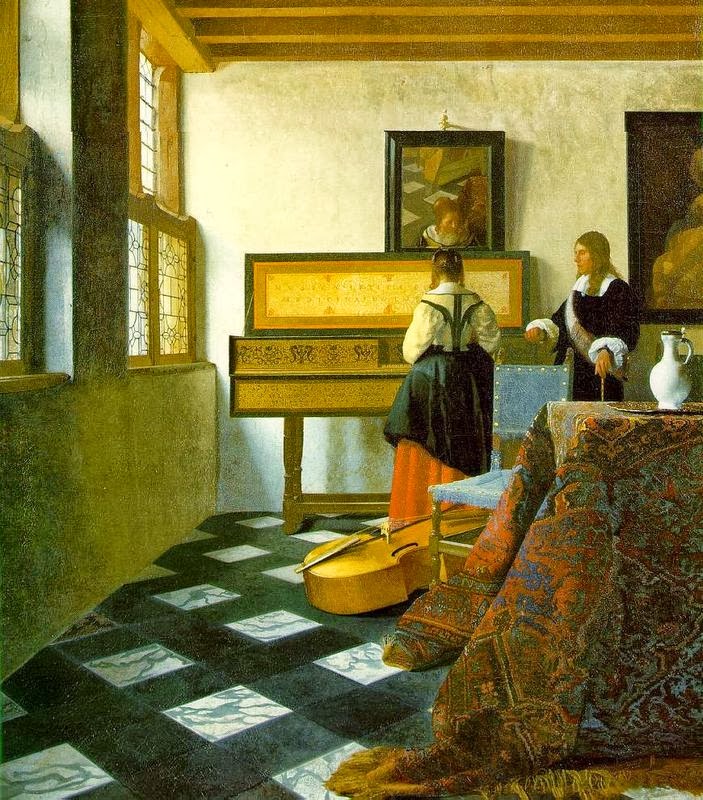Hi, Bryan Here….
I would imagine that only art students or avid art collectors would know the name Vermeer if it was spoken out loud, where the rest of us would have to Google his name and learn about this name. Vermeer is actually a name, well a last name in Johannes Vermeer, who was a great painter in the 1600s. His work is known all over the world and is sought after by royalty, celebrities, and very wealthy business people. What makes Vermeer standout than any other painter from the 1600s? Well that’s an interesting topic and question. It’s such a fascinating subject, that Penn and Teller (the magicians and entertainers) decided to make one of their famous documentaries about it.
This matter is is of great interest because Vermeer’s paintings are photo-realistic. That is odd, because, it would be very difficult or impossible to capture the lighting, shades, and intricate details that Vermeer captured in his paintings if he did it free hand from memory, which he and people claimed he did. Since Penn and Teller are in the business of calling ‘Bullshit‘, they seemed to have a great beginning to an incredible story, which was how did Vermeer really get the images so detailed in his paintings.
Luckily for Penn and Teller, they knew a guy named Tim Jenison, who is a very wealthy technologist, meaning he has invented and sketched the way for new technology over the past few decades. It also means that he might be a bored billionaire with some interesting hobbies, one of those being Vermeer. Tim had a theory that Vermeer in fact did NOT paint these free hand, but rather used new technology at the time to basically trace his paintings, thus he set out to prove his theory, which took seven years to prove from start to finish. Tim’s theory stated that Vermeer used a camera obscura, which was fairly new back in the 1600s, to project an image onto a canvas or wall.
The projected image is portrayed upside down, but what Tim figured out is if you place a mirror that reflects that image under your eye and on top of your canvas, you have the image that you can sketch perfectly as if you were tracing it. First off, Tim has never painted in his life. Hell, he didn’t even know how to hold a paintbrush correctly, but when he attempted to paint a portrait of someone as a trial run, it turned out spectacular, as if he has painted his entire life.
After a few more test runs, Tim decided to try this theory on an actual Vermeer painting, specifically the ‘The Music Lesson’, because of it’s intricate and vivid details on the rug and the lighting from the windows. But Tim didn’t want to use modern day technology. Instead, he wanted to recreate what it was like for Vermeer in the 1600s. So, being a billionaire, he constructed the room, according to the painting and used the old equipment that Vermeer would have used to get his photo-realistic paintings. And thus the real story is set in motion as Tim spent eight months painting a Vermeer.
We get to see the highs and lows of Tim’s psyche as he struggles to finish the painting, even saying to the camera “If this wasn’t for a movie, I would have quit already.” Tim, Penn and Teller, travel to England to meet with some famous artists who reflect on Vermeer and Tim’s theory as well as stop by Buckingham Palace to see the actual Vermeer painting, ‘The Music Lesson’, which is a comical bit in true Penn and Teller form. Throughout the documentary, seeing Tim paint different sections and how the small details are captured, we start to really believe that Vermeer indeed must have used this technique, even if it took many months to complete.
And maybe Vermeer wasn’t an artist, but one of the first technologists, just like Tim several hundred years later. In the end, Tim painted a Vermeer, and when he showed other art scholars and collectors his piece, they couldn’t believe it and said it might just be better than the original. ‘Tim’s Vermeer‘ is a short, fun, and interesting documentary about one man’s adventure to prove that a celebrated artist might have used technology to help him paint.
4 out of 5 STARS
-Bryan Kluger



